Mastering Your Go-To-Market Strategy: 7 Crucial Steps for Success (Plus Free PPT Template)
Launch your product with confidence. Our step-by-step guide shows you how to build a winning go-to-market strategy, plus grab our free PowerPoint template to get started.
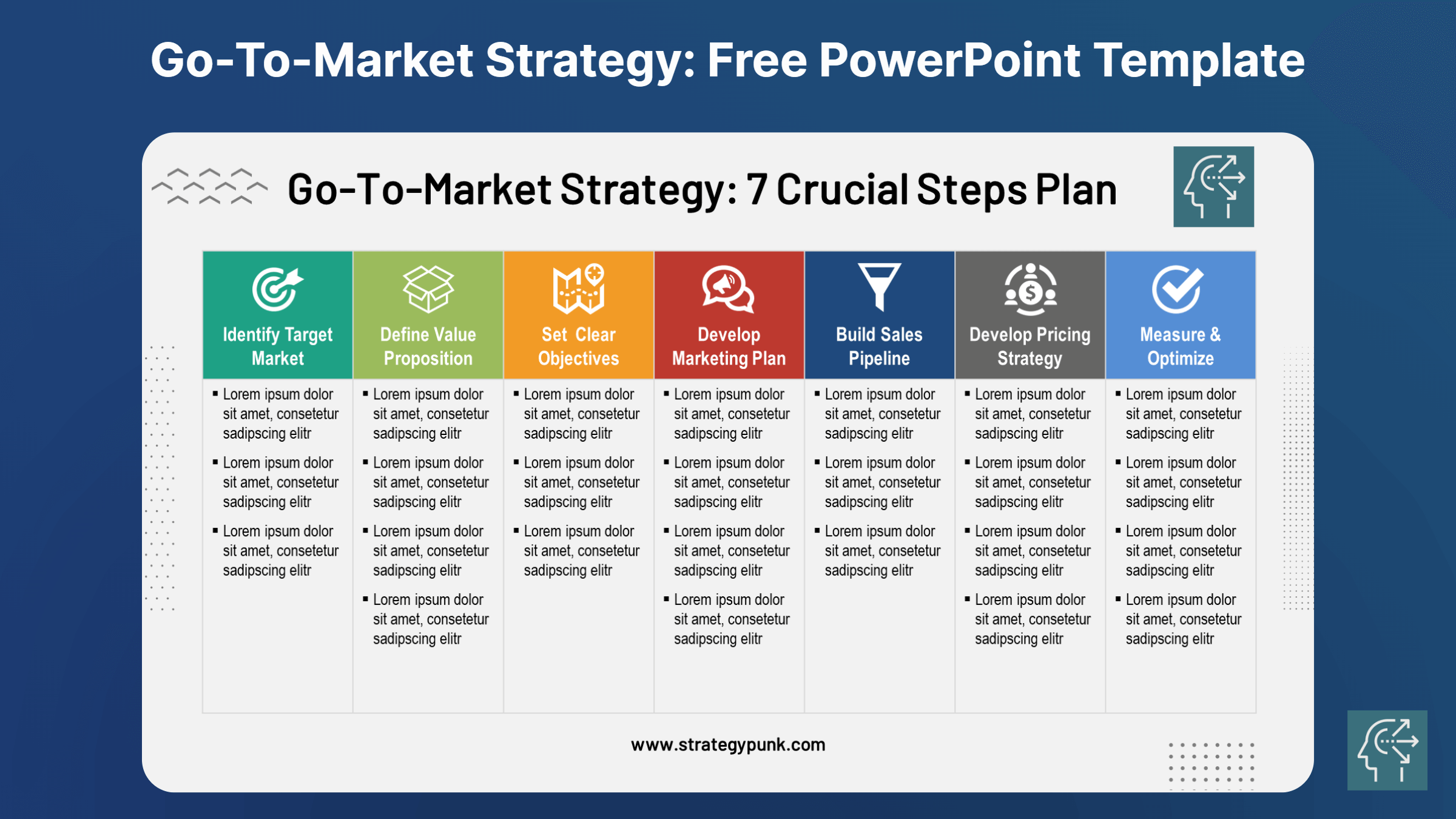
Introduction
Mastering your go-to-market strategy is crucial for the success of any business. It introduces a new product or service to the market and ensures it reaches the right audience. A well-executed strategy can help companies mitigate the risks associated with launching a new product or service and achieve their sales and marketing objectives.
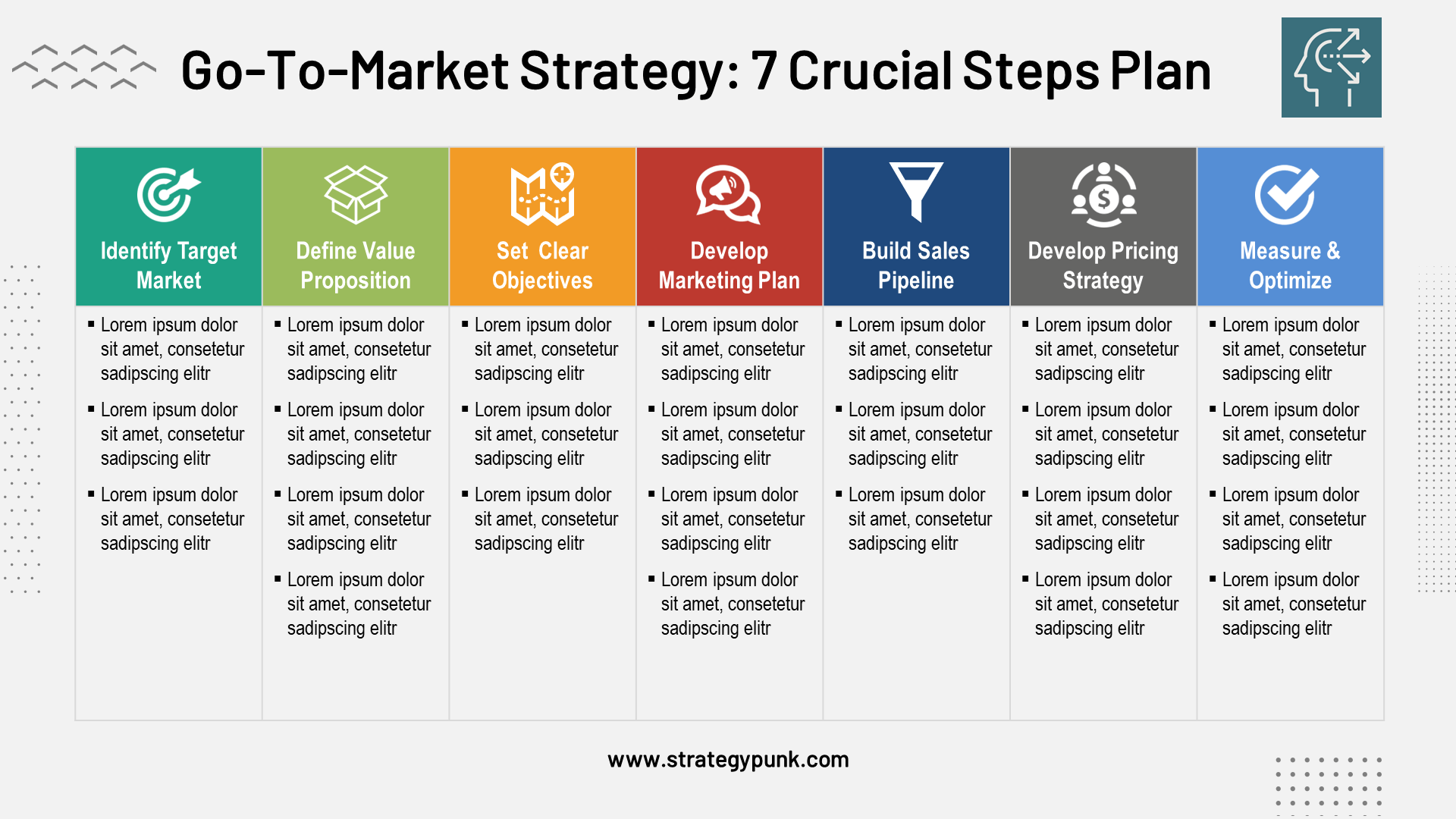
Businesses must follow seven crucial steps to master their go-to-market strategy. The first step is to identify the target market. This involves understanding the needs and preferences of the target audience and developing a product or service that meets those needs. The second step is to define the value proposition, which is the unique benefit that the product or service offers to the target audience. The third step is to set clear objectives that align with the business's overall goals and objectives.
The following steps in mastering your go-to-market strategy include developing a marketing plan, building your sales pipeline, developing a pricing strategy, and measuring and optimizing your results. A well-executed marketing plan can help businesses effectively reach their target audience and generate interest in their products or services. Building a strong sales pipeline is essential for converting leads into customers, while a well-defined pricing strategy can help businesses maximize their revenue. Ultimately, measuring and optimizing results can help companies pinpoint areas for improvement and make informed, data-driven decisions to refine their go-to-market strategy.
Identify Your Target Market
The first crucial step in mastering your go-to-market strategy is identifying your target market. Your target market is the group of customers who are most likely to purchase your product or service. To determine your target market, you must understand their characteristics, preferences, and behavior.
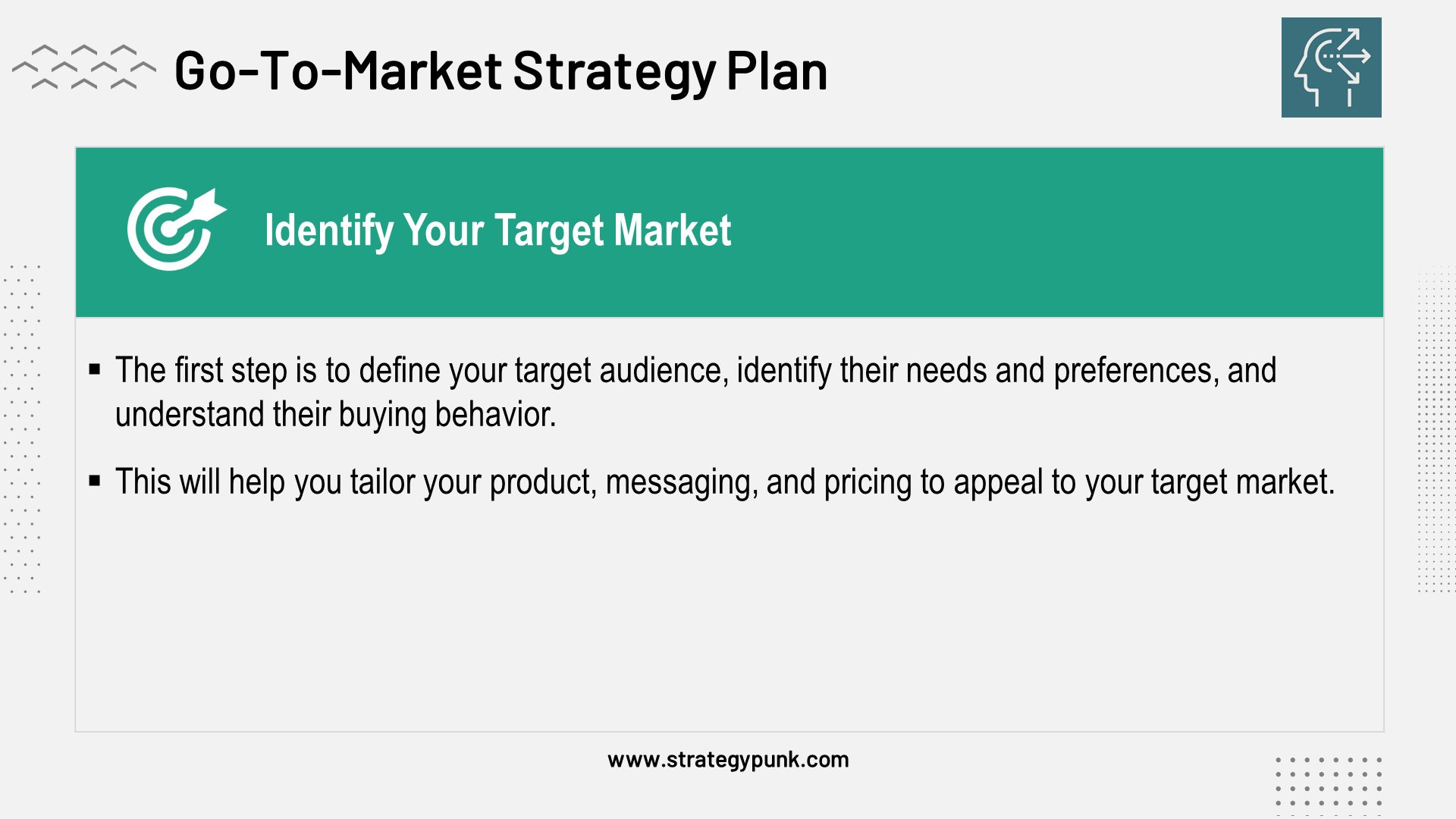
One way to identify your target market is to conduct market research. This can include surveys, focus groups, and analysis of industry reports. Market research enables you to gain insights into your target market's needs, preferences, demographics, buying habits, and pain points.
Another way to identify your target market is to create buyer personas. A buyer persona is a fictional representation of your ideal customer. It includes demographic information, such as age, gender, and income, as well as psychographic information, such as interests, values, and motivations. By creating buyer personas, you can gain a deeper understanding of your target market's needs and tailor your marketing messages to resonate more effectively with them.
Once you have identified your target market, you can develop a marketing strategy tailored to their needs and preferences. This strategy can include creating targeted advertising campaigns, producing content that addresses their pain points, and identifying the most effective channels for reaching them.
Define Your Value Proposition
Defining your value proposition is one of the most critical steps in developing a go-to-market strategy. Your value proposition is a statement that describes the unique benefit that your product or service provides to your target audience. It should communicate why your product or service is superior to those of your competitors and why your target audience should choose you over them.
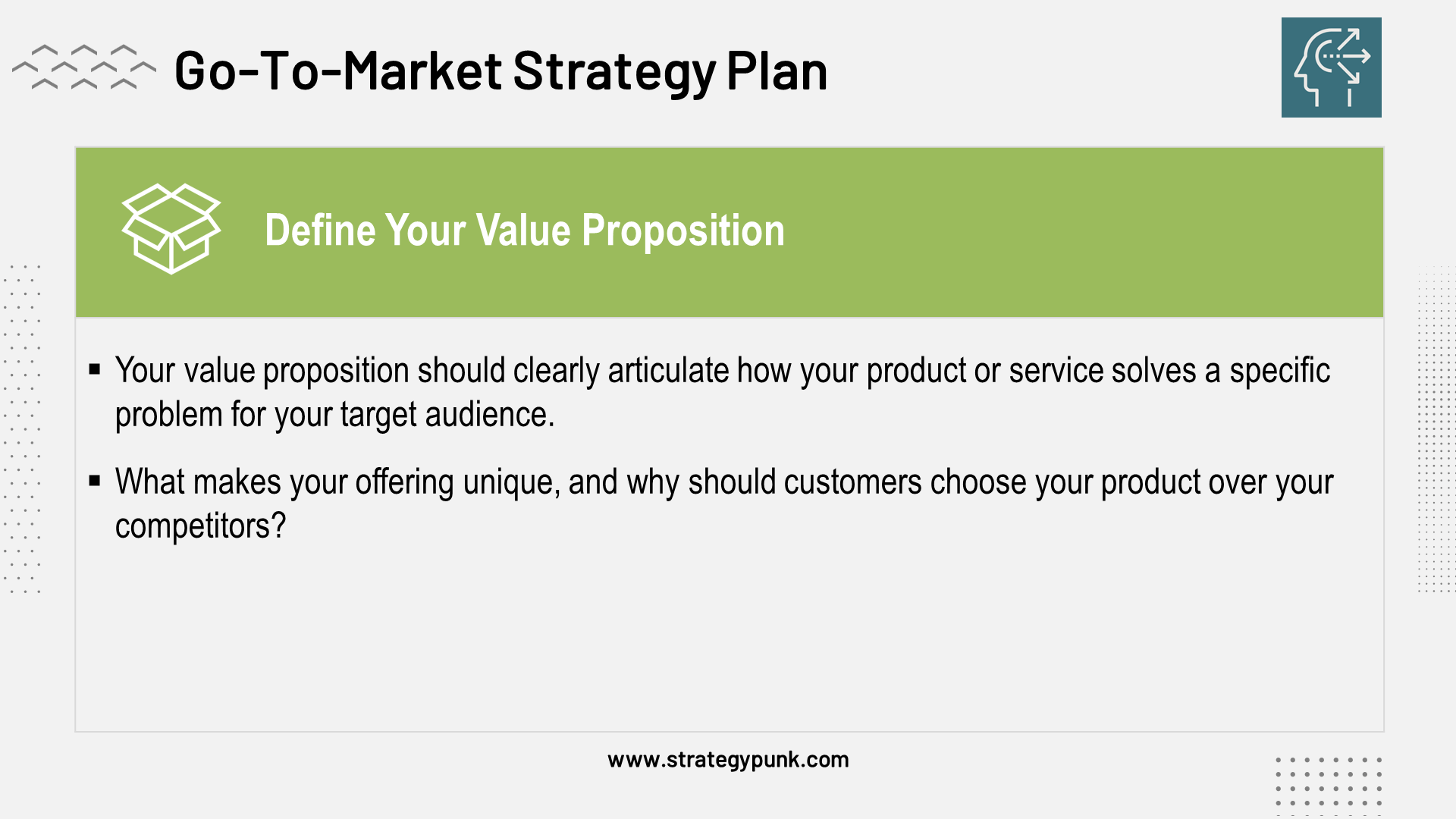
To define your value proposition, identify the key benefits of your product or service. Consider what sets you apart from your competitors and makes your offering unique. Then, consider your target audience's pain points and how your product or service can address them.
Once you have identified your key benefits, please make a clear and concise statement that outlines your value proposition. Your value proposition should be clear and resonate with your target audience. Use simple language and avoid jargon or technical terms that may confuse your audience.
Here are some tips to help you define your value proposition:
- Focus on the benefits of your product or service, not its features.
- Use language that resonates with your target audience.
- Be clear and concise.
- Communicate your unique selling proposition.
- Highlight the value that your product or service provides.
By defining your value proposition, you can differentiate your product or service from those of your competitors and effectively communicate to your target audience the benefits of choosing your offering.
Set Clear Objectives
Setting clear objectives is a crucial step in developing a successful go-to-market strategy. Your goals should be specific, measurable, achievable, relevant, and time-bound. This will help you stay focused and ensure everyone on your team works toward the same goals.
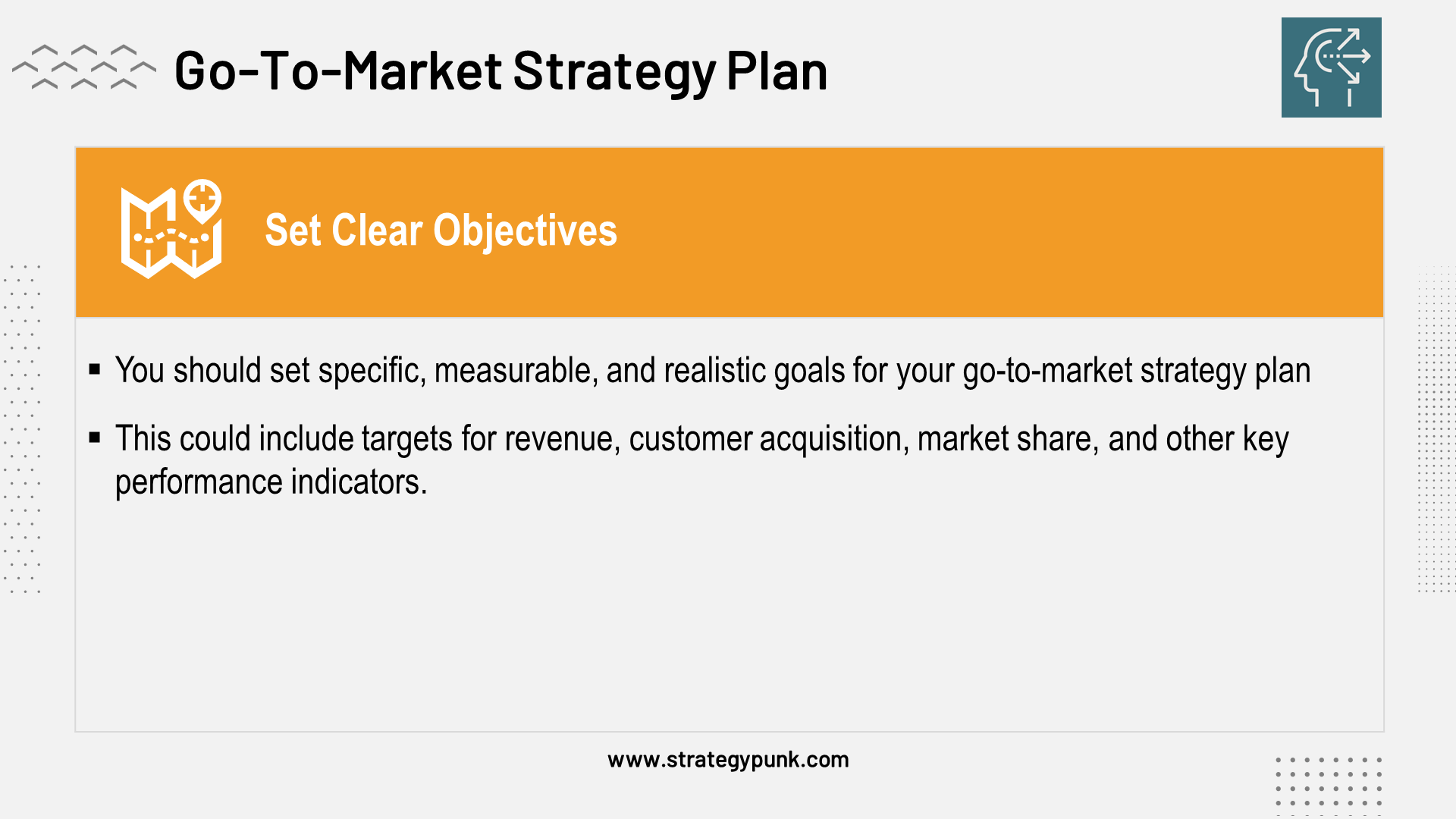
When setting your objectives, you must consider your target market, value proposition, and sales pipeline. Your objectives should align with these critical areas, helping you achieve your business goals. For example, if your value proposition is focused on providing a low-cost solution to a common problem, your objectives may include increasing market share and reducing customer acquisition costs.
It's also essential to set realistic and achievable objectives. While it's important to aim high, setting unrealistic goals can lead to frustration and demotivation. By setting achievable objectives, you can build momentum and celebrate small wins.
To help you set clear objectives, consider using the SMART framework:
| Specific | Your objectives should be clear and specific. |
|---|---|
| Measurable | Your objectives should be measurable so that you can track progress and success. |
| Achievable | Your objectives should be realistic and achievable. |
| Relevant | Your objectives should be relevant to your overall business goals. |
| Time-bound | Your objectives should have a specific timeline for completion. |
By following these steps and utilizing the SMART framework, you can establish clear objectives that will aid in developing a successful go-to-market strategy.
Develop a Marketing Plan
Once you have identified your target market and defined your value proposition, the next step is to develop a marketing plan that helps you reach your target audience and effectively communicate the benefits of your product or service.
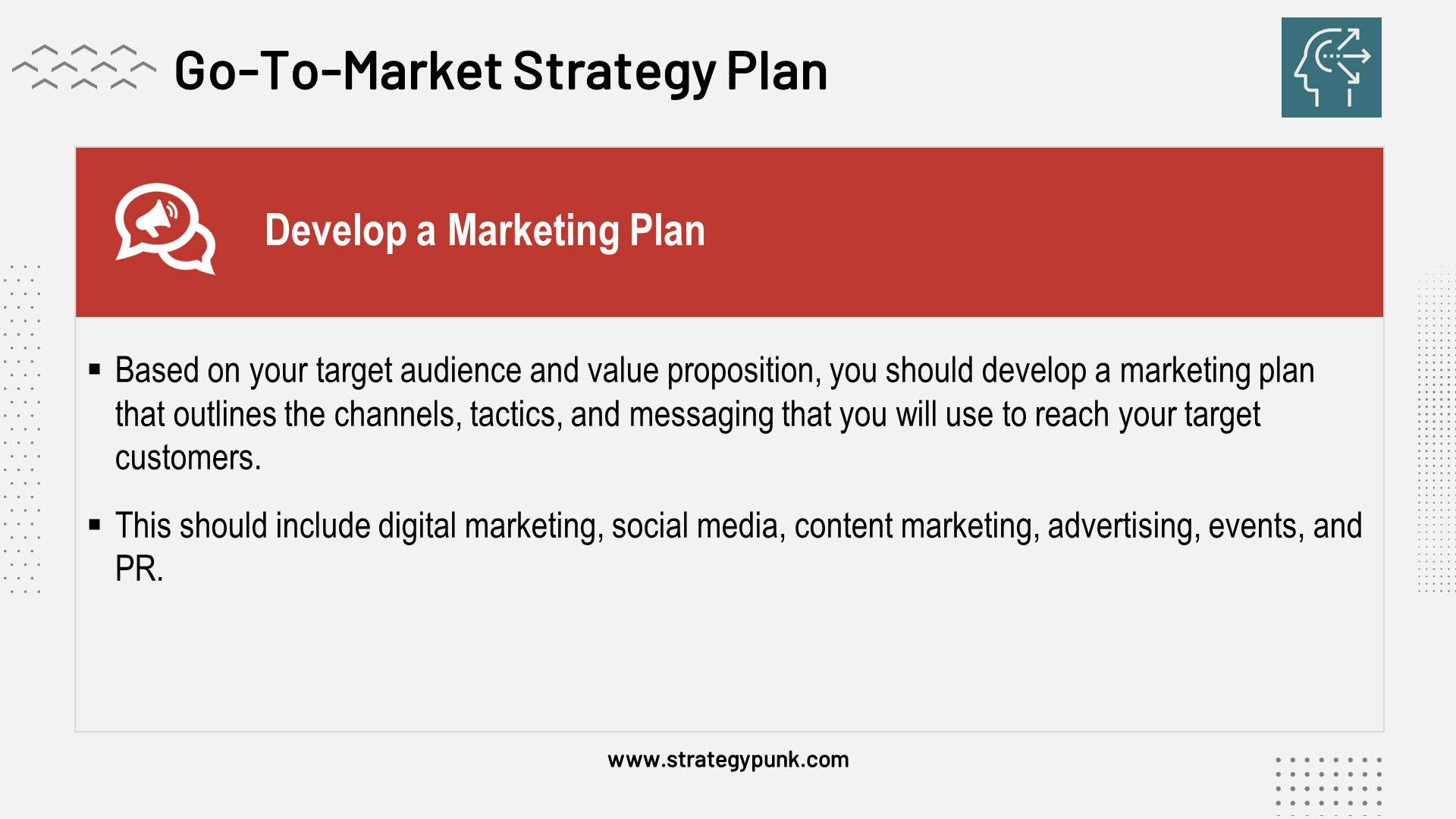
A marketing plan should include a detailed analysis of your target market, including their demographics, interests, and behaviors. This information will help you tailor your messaging and marketing tactics to resonate with your audience.
Next, you should identify the most effective marketing channels for reaching your target audience. This may include social media, email marketing, content marketing, and paid advertising. Each track should be evaluated based on its potential reach, cost-effectiveness, and ability to generate leads and conversions.
Once you have identified your marketing channels, you should develop a content strategy that aligns with your value proposition and target audience. This may include creating blog posts, videos, infographics, whitepapers, and other types of content that provide value and help establish your brand as a thought leader in your industry.
Ultimately, it would be beneficial to establish metrics for measuring the success of your marketing plan. This may include tracking website traffic, email open rates, social media engagement, and conversion rates. Regularly monitoring and optimizing your marketing efforts ensures that your go-to-market strategy is effective and generates the desired results.
Build Your Sales Pipeline
Building a sales pipeline is a crucial step in your go-to-market strategy. A sales pipeline is a visual representation of your sales process, from the initial contact with a potential customer to closing the deal. By building a sales pipeline, you can stay organized, track your progress, and pinpoint areas for improvement.
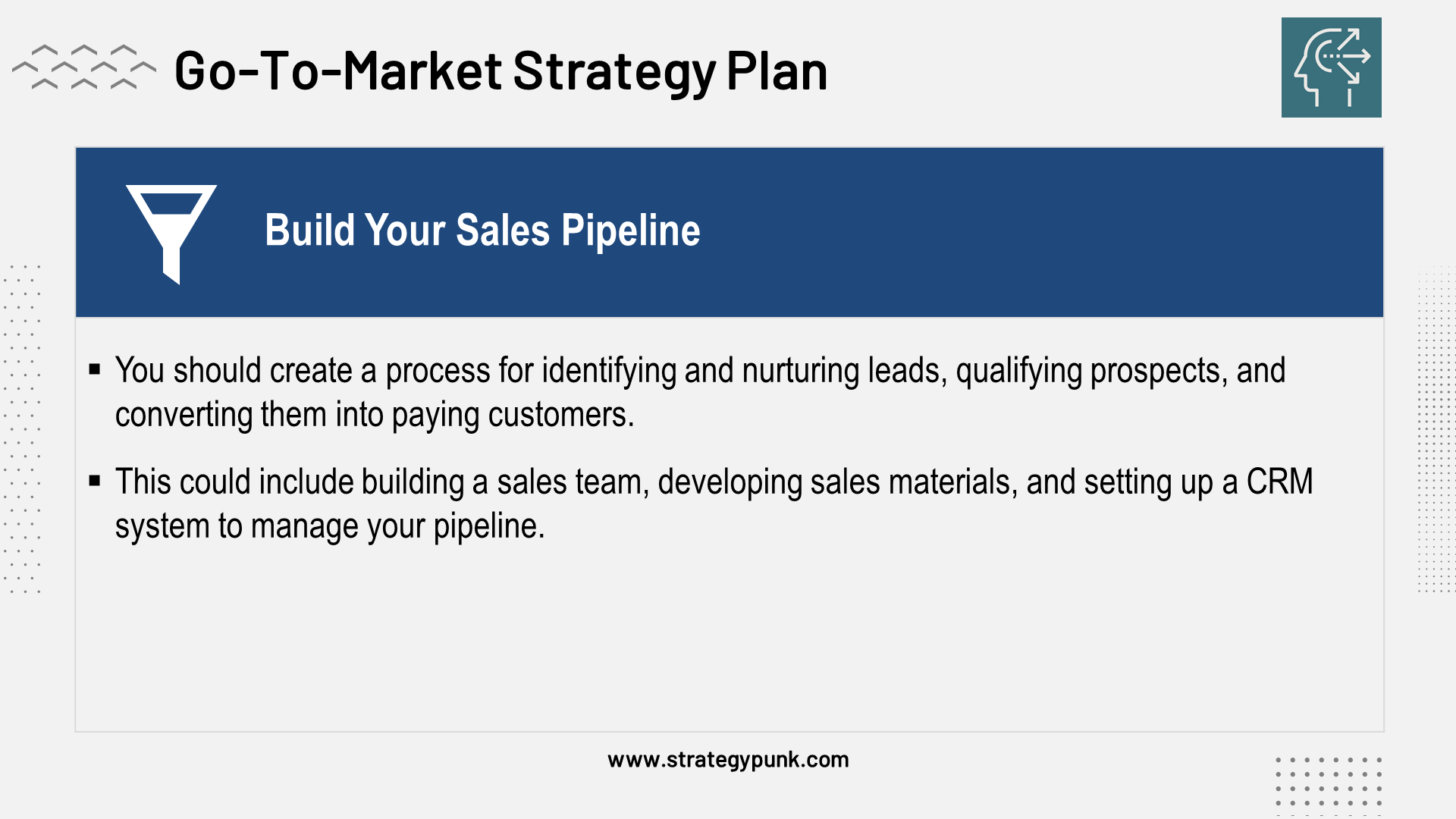
Here are some steps you can take to build a successful sales pipeline:
- Define the stages of your sales: Start by identifying the stages your prospects move through as they progress through your sales process. This will help you understand where they are in the buying process and what actions you need to take to move them to the next stage. Standard sales stages include prospecting, qualifying, proposing, and closing.
- Identify your ideal customer: Before building your pipeline, you must know who you're targeting. Consider demographics, industry, company size, and pain points to identify your perfect customer. This will help you tailor your sales approach to their specific needs.
- Develop a lead generation strategy: Once you know who you're targeting, you must find them. Your strategy should include tactics like content marketing, social media outreach, and email campaigns.
- Qualify your leads: Not all charges are created equal. It would be best to qualify your leads to ensure they're a good fit for your product or service. Consider factors such as budget, timeline, and decision-making authority.
- Track your progress: Use a CRM or other sales tracking tool to monitor your progress and identify areas for improvement. This will help you stay organized and ensure you don't miss any opportunities.
Following these steps will help you build a successful sales pipeline, enabling you to close more deals and grow your business.
Develop a Pricing Strategy
Developing a pricing strategy is a crucial step in your go-to-market plan. It involves determining the right price for your product or service to attract customers and generate revenue for your business. Here are some key factors to consider when developing your pricing strategy:
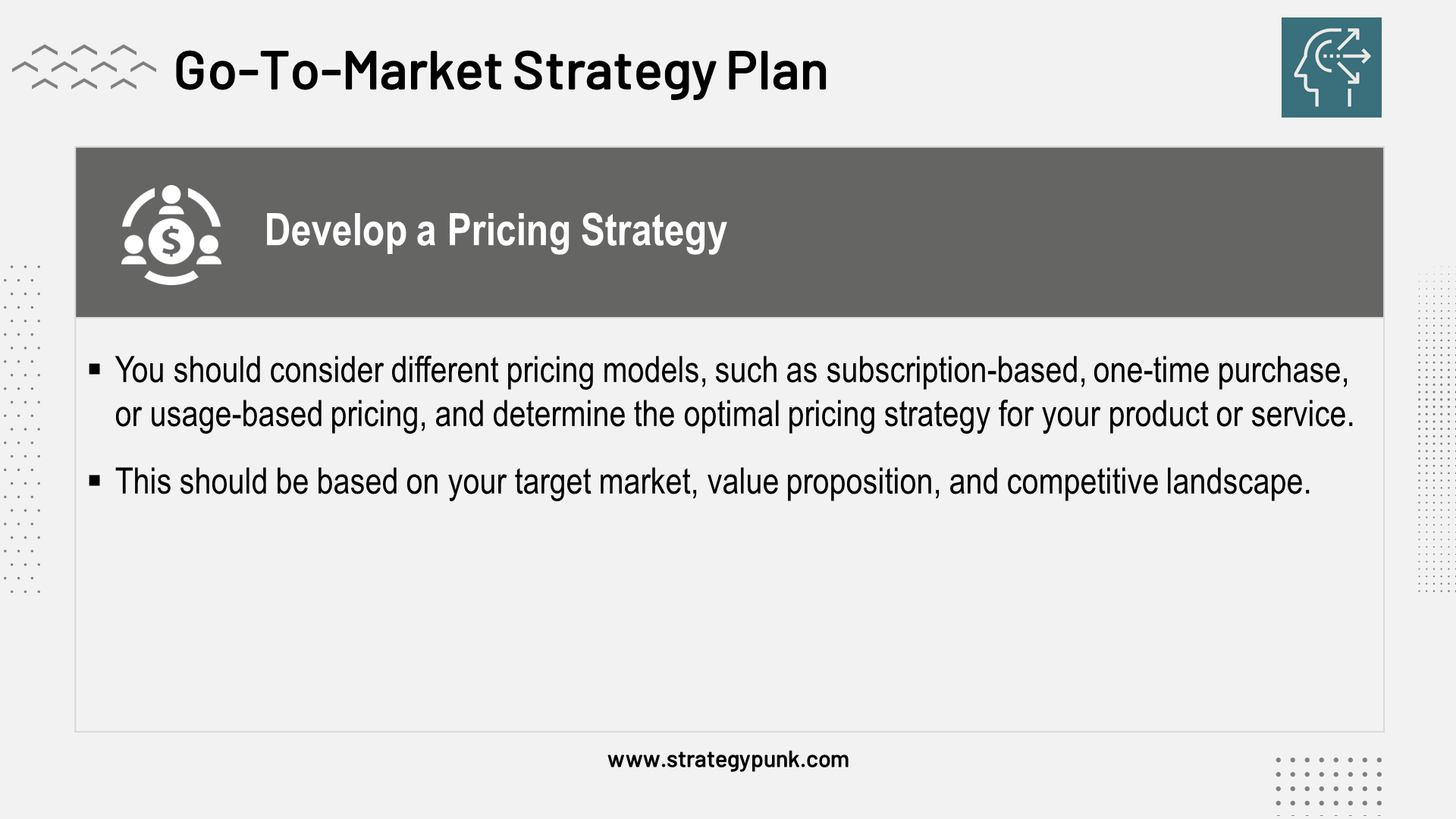
- Costs: Consider the costs associated with producing and delivering your product or service, including materials, labor, overhead, and other relevant expenses. Your price should cover these costs and provide a profit margin.
- Competitors: Research your competitors' pricing strategies to determine how your product or service compares to theirs. You may need to adjust your pricing to be competitive in the market.
- Value: Consider the value of your product or service to your customers. If it offers unique features or benefits, you may be able to charge a premium price.
- Market: Consider the market demand for your product or service. If demand is high, you may be able to charge a higher price.
Once you have considered these factors, you can determine your pricing strategy. There are several pricing strategies you can use:
| Pricing Strategy | Description |
|---|---|
| Cost-Plus Pricing | Add a markup to your costs to determine the price. |
| Value-Based Pricing | Set your price based on the value your product or service provides to customers. |
| Penetration Pricing | Set a low price to enter the market and gain market share. |
| Skimming Pricing | Set a high price to target early adopters and generate revenue quickly. |
It's essential to regularly evaluate and adjust your pricing strategy in response to market conditions and customer feedback. This will help ensure that your business's pricing remains competitive and profitable.
Measure and Optimize
Once you have launched your product and started selling, measuring your success and optimizing your strategy is essential. This involves tracking key performance indicators (KPIs) and making data-driven decisions to improve your go-to-market strategy.
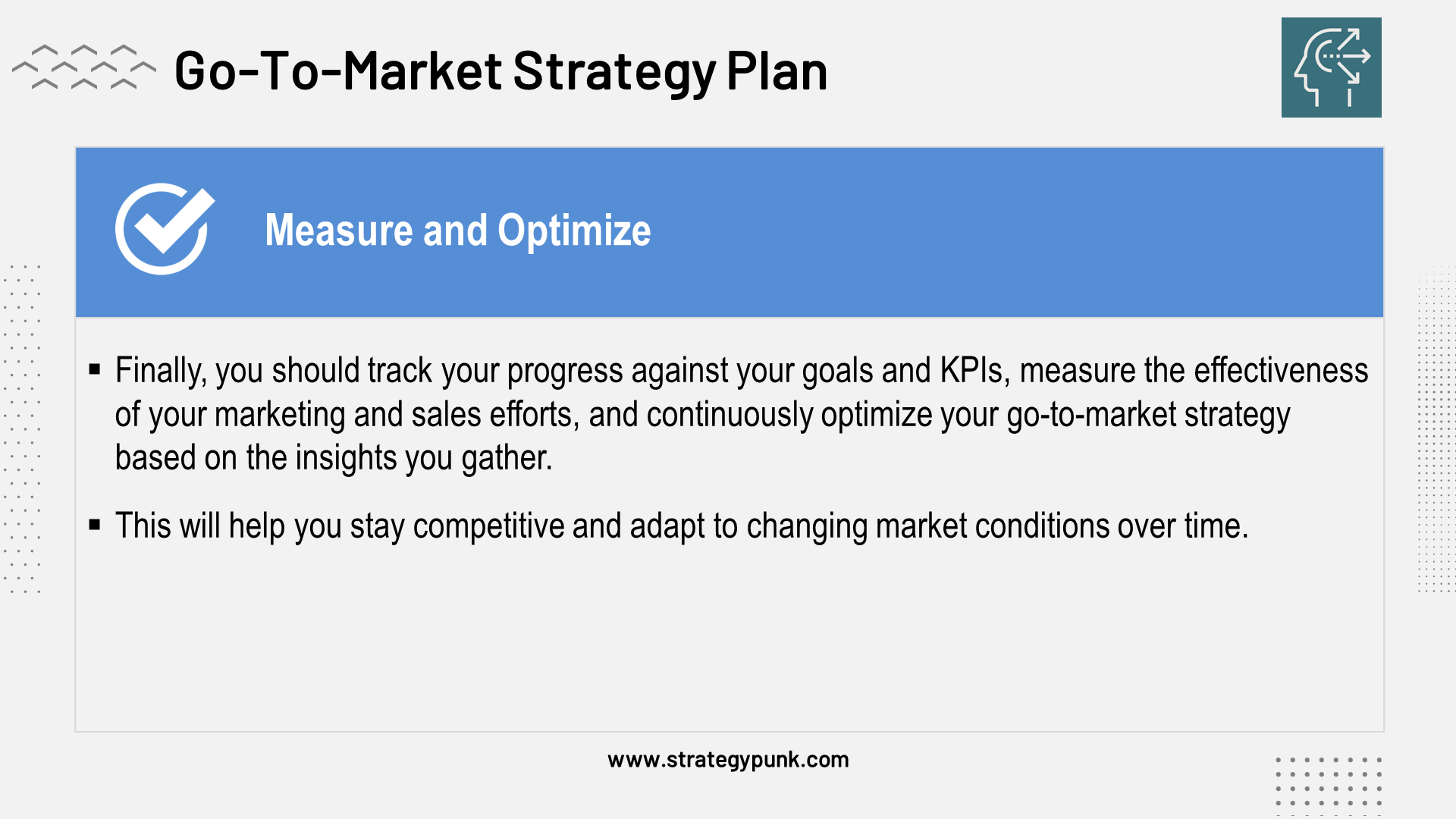
Some essential key performance indicators (KPIs) to track include customer acquisition cost (CAC), customer lifetime value (CLV), conversion rates, and revenue growth. By regularly monitoring these metrics, you can pinpoint areas for improvement and adjust your strategy to boost profitability and drive growth.
In addition to tracking KPIs, gathering and using customer feedback to optimize your product and marketing strategy is essential. This can involve conducting customer surveys, analyzing customer reviews, and monitoring social media channels for customer feedback.
Another critical aspect of measuring and optimizing your go-to-market strategy is A/B testing. By testing different versions of your marketing materials, pricing strategy, and product features, you can determine what works best and make informed, data-driven decisions to enhance your strategy.
Measuring and optimizing your go-to-market strategy is an ongoing process that requires a commitment to data-driven decision-making and continuous improvement. By regularly tracking key performance indicators (KPIs), gathering customer feedback, and conducting A/B testing, you can ensure that your strategy continually evolves and improves to meet the needs of your target market.
Executive Summary
Here are the seven most essential steps in developing a go-to-market strategy plan:
- Identify Your Target Market: The first step is to define your target audience, identify their needs and preferences, and understand their buying behavior. This will help you tailor your product, messaging, and pricing to appeal to them.
- Define Your Value Proposition: Your value proposition should clearly articulate how your product or service solves a specific problem for your target audience, what makes your offering unique, and why customers should choose it over your competitors.
- Set Clear Objectives: Your go-to-market strategy plan should include specific, measurable, and realistic goals. These could consist of targets for revenue, customer acquisition, market share, and other key performance indicators.
- Develop a Marketing Plan: Based on your target audience and value proposition, develop a marketing plan that outlines the channels, tactics, and messaging you will use to reach your target customers. This should encompass digital marketing, social media, content marketing, advertising, events, and public relations (PR).
- Build Your Sales Pipeline: Develop a process for identifying and nurturing leads, qualifying prospects, and converting them into paying customers. This could include building a sales team, developing sales materials, and setting up a CRM system to manage your pipeline.
- Develop a Pricing Strategy: Consider different pricing models, such as subscription-based, one-time purchase, or usage-based pricing, and determine the optimal pricing strategy for your product or service. This should be based on your target market, value proposition, and competitive landscape.
- Measure and Optimize: Finally, you should track your progress against your goals and KPIs, measure the effectiveness of your marketing and sales efforts, and continuously optimize your go-to-market strategy based on the insights you gather. This will help you stay competitive and adapt to changing market conditions.
Go-To-Market Strategy Template
Free and fully editable PowerPoint Template
Are you looking to develop a successful go-to-market strategy plan for your business?
Look no further!
We've compiled a comprehensive guide outlining the seven key steps to success.
To make things even easier, we've also created a free and fully editable PowerPoint template that you can use to create a professional and visually appealing go-to-market strategy presentation.
Whether you're a startup or an established business, our guide and template will help you develop a winning strategy that drives growth and maximizes your return on investment (ROI).
If my content or templates have been valuable and saved you time, consider supporting my work with a small donation. Your support helps me keep creating helpful resources!





